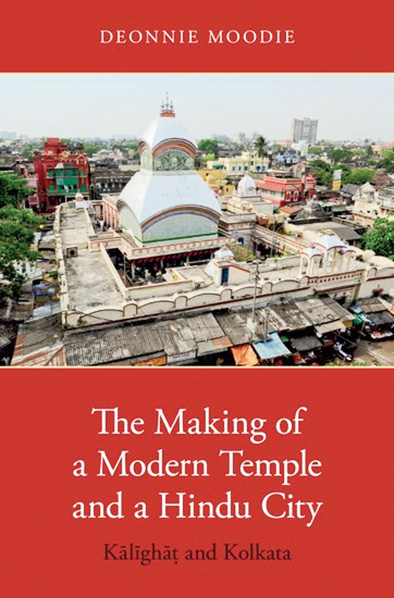Salt Lake recently had a visitor from the US who went — not shopping or sight-seeing but — visiting as many temples as she could.
Deonnie Moodie is a pass-out from Harvard Graduate School of Arts and Sciences with a PhD in the Study of Religion. Now an assistant professor of South Asian religions at the University of Oklahama, Deonnie has spent years studying the Kalighat temple and has written the book The Making of a Modern Temple and a Hindu City.
The Telegraph Salt Lake spoke to Deonnie when she had come to visit temples in Salt Lake.
What got you interested in this topic?
Well, I first came to India in 2002 while pursuing an under graduate course on religions of India. I travelled to 11 cities, including Calcutta, where I visited Dakshineshwar and Kalighat.
Eventually I specialised in religions of urban India and religions in modernity, mainly in Calcutta. I lived in Tollygunge for a year and learnt to speak and read Bengali too.
Why Calcutta and why Kali?
When the Europeans wrote the history of Calcutta they began with the arrival of Job Charnock in the 1600s. They made it seem like there was nothing but marshes here before that and it is they who built the city. But later when Bengalis started writing history they said it’s not a city of Charnock but Kali and Kalighat.
Kali is Ma. She gives, she takes away…I’ve seen people keep her picture behind their phones and turn to it in times of trouble. But for me the most interesting was how the Kalighat temple has been central to creating an Indian and Bengali modernity. Kali doesn’t become irrelevant when people become modern. In fact, she stays central to the modernising efforts.
How is that?
When Kalighat became a public temple in the 20th century, the upper-middle class came out and voiced complaints. They complained about misappropriation of funds received as donations, greedy pandas (touts), dishonest sevaits, about the temple being dirty, disorganised…. They talked about it, wrote about it to newspapers and even lodged public interest litigations.
But have the court rulings brought about real change?
The court can pass a ruling but if a chunk of devotees, pandas and sevaits oppose it, what can be done?
CCTVs have been installed to keep an eye on things but as for matters like cleanliness, it boils down to what you classify as dirt. The court may say petals and blood on the floor are dirt but blood is part of what the temple is; Kali receives blood as sacrifice.
Devotees run to smear the spilt blood on their heads as tika or take it home in jars to ward off evil. What is dirt to one is sacred to another.
The beggars who live on the temple grounds are opposed to renovation as they will have nowhere to go. There’s also a school that believes that Kali gave the sevaits the right and responsibility to worship her and so who is anyone else to say they’re doing it wrong?
Is religion important to urban Indians today?
Well, many may not go to Kalighat anymore citing the dirt and harassment but they still ask their domestic helps to go make a sacrifice on their behalf.
People create the temples they need. My landlord, for instance, had a thakur ghor inside his cupboard!
This is what I want to focus on next — home shrines. Community is a big part of religion so people still go to temples but home shrines are increasingly getting important.
I’ve studied Bengalis in the US too and while they celebrate Durga, Kali or Saraswati puja, temples are not that important to them. Most temples in the US have pictures of many gods but the temples themselves are built by south Indians, with typical southern architecture.
What brought you to Salt Lake?
Well, I want to study how religion is practised in suburbs like this one. I mean Salt Lake is a planned township with space earmarked right from the start for parks, markets and hospitals but why not for temples?
I agree Salt Lake was planned by a Yugoslav architect-planner (Dobrivoje Toskovic) but he did it in consultation with BC Roy and other Indians so why this glaring omission?
But like I said, people create the temples they need…under trees, outside their complexes…. (On this trip Deonnie visited a Shani temple under a tree outside GD Market, the EC Block Kali temple, the CRPF Camp Shiva temple and Loknath temple outside the stadium).
How religious are people in the US?
Well, just like in India, some Americans are religious, some are not. On Sunday mornings gyms and libraries are more likely to be crowded than churches. But people think of god as a source of strength.
My students are interested in religion. Most have never met a Hindu, Muslim, Jain or Sikh before. They may have stereotypes in their minds and are not comfortable discussing them with their families. They come to my class to gain exposure.
And which god do you pray to?
I am culturally a Christian, married to a Jew. My job is not to give verdict on which religion is right and wrong. I don’t judge, I just want to know what you believe.
My husband and I are raising our son to be curious about religion. We’re telling him we don’t know what happens after death and so we have to focus on our actions now as what we do affects one other.

The cover of Deonnie’s book, that was launched on Kali puja this year in the US Telegraph picture

Deonnie at the Shani temple under a tree outside GD Market. Brinda Sarkar










